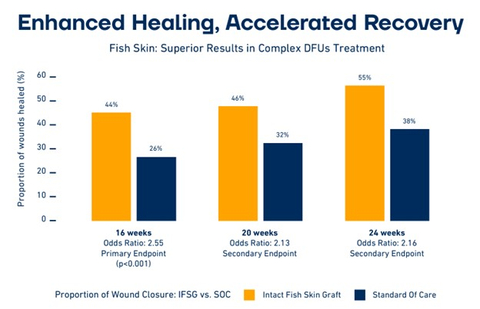Kerecis’ fish-skin grafts significantly outperformed the standard of care in closing severe diabetic foot ulcers, a new study shows.
The study was presented at the Symposium on Advanced Wound Care (SAWC) in Las Vegas and simultaneously published in the New England Journal of Medicine Evidence.
The study included 255 patients at 15 care centers across four countries. At 16 weeks, 44% of diabetic foot ulcers treated with Kerecis Fish-skin Grafts in conjunction with the standard of care had healed, compared with 26.4% using standard of care. This trend continued, with 55.2% of fish-skin graft-treated wounds healed at 24 weeks versus 37.8% for standard care, the study showed.
Standard of care included harp debridement, off-loading, diabetic foot education, local wound care, dressings, vascular assessment, general medical assessment, treatment of infections, and glycemic control.
In the study, diabetic foot ulcers treated with intact fish-skin graft were associated with faster wound closure time, with the wounds healing approximately two weeks earlier and with a 1.6x greater chance of wound closure at any time point.
The study “is pivotal in diabetic foot ulcer treatment, especially for the more complex grades 2 and 3 cases,” says Kerecis Scientific Advisory Board Chairman John Lantis, MD, in a news release. It “paves the way for a promising shift in clinical practice, where fish skin treatment may soon become the go-to option for managing severe diabetic foot ulcers, ultimately leading to better patient outcomes and quality of life.”
Fertram Sigurjonsson, founder and CEO of Kerecis, adds, “By conducting the largest randomized controlled trial for complex diabetic foot ulcers that expose bone, tendon, or joints to date, we are breaking new ground in treatment of serious wounds and tissue damage. I am very proud to bring hope to patients who face the highest risks of complications and amputations, showing that innovative solutions can truly transform lives. Our team is committed to bringing our revolutionary treatment to healthcare providers and patients around the world, working toward our mission of making the Kerecis fish-skin the standard of care for serious wounds worldwide.”


